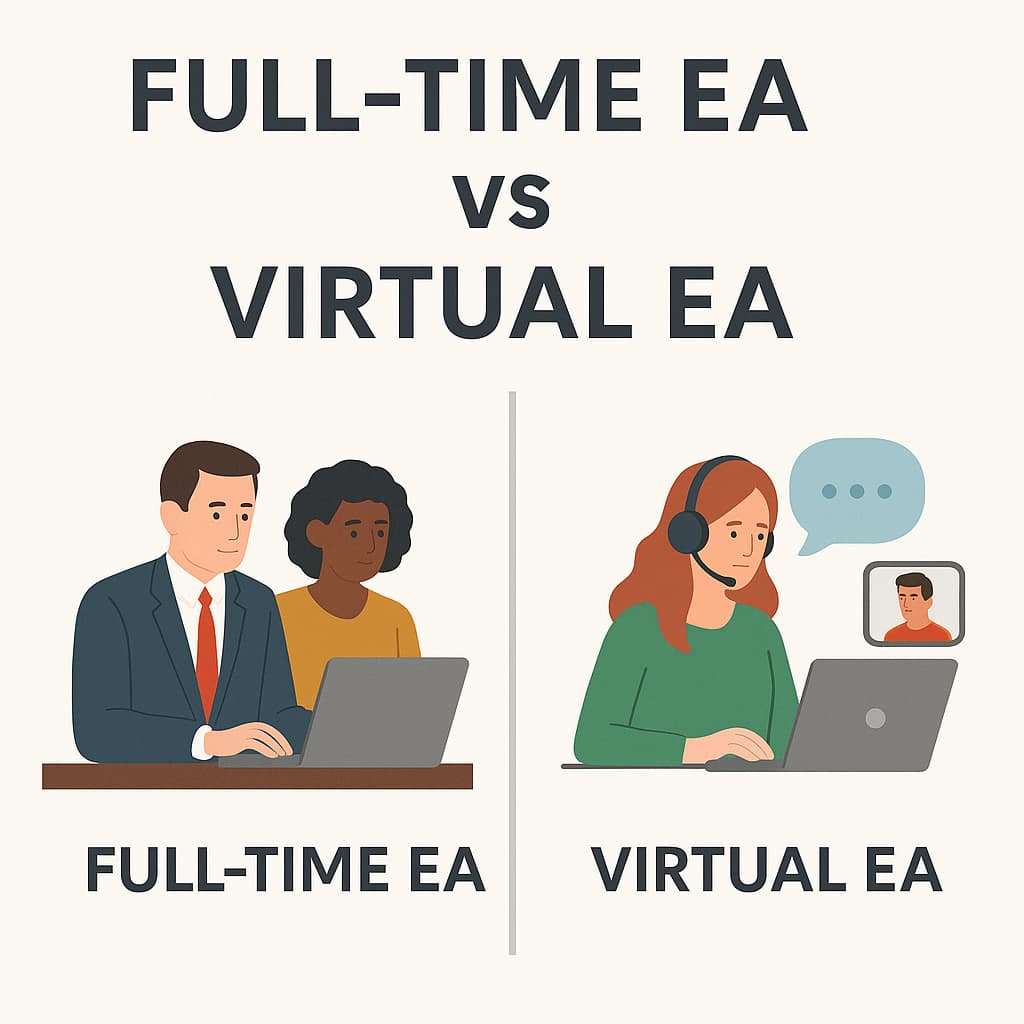If you’re scaling your business or juggling competing priorities, you’ve probably asked yourself this question: Should I hire a full-time Executive Assistant or go virtual?
It’s a big decision that impacts not only your schedule but also your bottom line and leadership bandwidth.
The truth is, both models have real value. A full-time EA brings in-person support and deep integration into your daily world. A virtual EA offers flexibility, specialized skills, and the freedom to scale without adding another salary to your payroll.
In this post, we’ll break down the full-time EA vs virtual EA debate so you can make a confident, strategic choice that fits how you actually work, not just how you think you should.
What Does a Full-Time Executive Assistant Offer?
A full-time Executive Assistant (EA) is often the right hand of a leader. They work in the same office or closely alongside you, managing everything from scheduling and email to strategic projects.
Strengths of a Full-Time EA
- Consistent presence. They’re physically available and ready to jump into meetings or handle urgent tasks in real time.
- Deep understanding of your world. Because they’re part of your daily rhythm, they learn your communication style, preferences, and can anticipate your needs.
- Strong company loyalty. They’re part of the internal team, building relationships across departments and maintaining a clear view of company dynamics.
- Immediate collaboration. When projects move quickly, having someone nearby to review a deck or coordinate last-minute logistics can make all the difference.
A full-time EA also comes with higher fixed costs such as salary, benefits, workspace, and ongoing training. Their workload may not always match your business needs, especially if your schedule changes seasonally or project loads fluctuate.
Still, for leaders who need a consistent, in-person presence, that investment can create a seamless, dependable partnership that keeps everything moving smoothly.
What Makes a Virtual Executive Assistant Different
A Virtual Executive Assistant (Virtual EA) offers the same high-level support as a traditional EA but works remotely. This approach gives business leaders flexibility and access to a much wider talent pool beyond their city or even country.
Strengths of a Virtual EA
- Flexible support. You can adjust hours and responsibilities as your workload changes.
- Specialized expertise. Many Virtual EAs bring advanced skills such as CRM management, social media scheduling, bookkeeping, or travel coordination.
- Global reach. You can hire someone who fits your time zone or one who can cover work while you sleep.
- Lower overhead. You don’t have to cover office space, equipment, or benefits. You pay for productivity, not presence.
Working with a Virtual EA requires clear communication systems and strong processes. Time zone differences can be either an advantage or a challenge depending on your setup. Building trust takes consistency since your assistant won’t be sitting across the desk from you.
Still, for many leaders, the trade-offs are worth it. A skilled Virtual EA can become a trusted partner who understands your priorities and helps your business run efficiently without the need for a physical office presence.
Full-Time EA vs Virtual EA: Key Differences at a Glance
When deciding between a full-time EA and a virtual EA, it helps to look at how they differ in key areas.
A full-time EA is embedded in your organization. They’re in the office, fully integrated into your team culture, and often handle a broad range of administrative and personal support tasks. Their role works best when you need constant availability and hands-on assistance.
A virtual EA provides remote support using digital tools like Slack, Asana, and Zoom. They’re usually more flexible and may specialize in areas like project coordination, content management, or client outreach. They work well for leaders who prioritize efficiency, autonomy, and cost savings.
In short, a full-time EA offers depth and presence, while a virtual EA delivers flexibility and scalability. The right choice depends on your leadership style, company setup, and how much you value in-person interaction.
When a Full-Time EA Makes More Sense
A full-time Executive Assistant is the right choice when your role demands constant, hands-on support. If you run an office-based team, attend frequent in-person meetings, or manage sensitive information that can’t easily leave the workplace, having someone by your side every day can be invaluable.
Scenarios Where a Full-Time EA Shines
- You need on-site coordination. When your days are filled with in-person meetings, office management, or events, having an assistant physically present keeps everything running smoothly.
- You value face-to-face interaction. Some leaders thrive on collaboration and quick verbal check-ins rather than written messages or calls.
- Your schedule changes constantly. If your priorities shift by the hour, a full-time EA can pivot with you in real time.
- You handle sensitive information. In industries like law, finance, or healthcare, a full-time EA ensures privacy and confidentiality.
A full-time EA isn’t just about convenience. It’s about control, presence, and integration. When your workday relies on instant communication, body language, and spontaneous decisions, having someone in the room can make all the difference.
When a Virtual EA Is the Smarter Choice
A Virtual Executive Assistant makes sense when your business operates remotely or you value flexibility over proximity. Virtual EAs are ideal for entrepreneurs, consultants, and executives who travel frequently or manage distributed teams.
Scenarios Where a Virtual EA Excels
- You run a hybrid or remote company. If your team already communicates online, a virtual EA fits naturally into your workflow.
- You need flexibility. A virtual EA can adapt to busy seasons, scaling hours up or down as your needs evolve.
- You want specialized support. Many virtual EAs offer expertise in tools, systems, and project management that go beyond basic admin work.
- You’re cost-conscious. With no office overhead or benefits to cover, hiring virtually is often more affordable and efficient.
A Virtual EA helps you delegate without borders. You can find top-tier support without being limited by location, which is especially valuable if your day spans multiple time zones or your projects require different skill sets at different times.
Blending the Two: The Hybrid EA Model
Sometimes, the best choice isn’t one or the other. A growing number of leaders are finding success with a hybrid EA model, where both a full-time and a virtual assistant work together to cover different aspects of executive support.
How the Hybrid Approach Works
A full-time EA manages your local, in-person tasks such as meetings, office logistics, or event coordination. Meanwhile, a virtual EA handles specialized or time-consuming work like inbox management, client follow-ups, scheduling across time zones, or content publishing.
This setup creates balance. You maintain the personal connection and hands-on support of a full-time EA, while gaining the flexibility, scalability, and efficiency of a virtual one. For many growing companies, this blend delivers the best of both worlds.
Choose What Supports Your Leadership
At the end of the day, the decision between a full-time EA vs virtual EA isn’t about job titles. It’s about leadership style.
If you value in-person collaboration and real-time responsiveness, a full-time EA can become the steady anchor of your daily operations. If you prefer flexibility, digital efficiency, and cost savings, a virtual EA may be your perfect match.
The most effective leaders choose the model that helps them lead better, think clearer, and create more space for what truly matters.
Ready to simplify your workday and experience seamless virtual executive support? Let’s chat.

